The Radeon HD 5970: Completing AMD's Takeover of the High End GPU Market
by Ryan Smith on November 18, 2009 12:00 AM EST- Posted in
- GPUs
Radeon HD 5970 Eyefinity on 3 x 30" Displays: Playable at 7680 x 1600
TWiT's Colleen Kelly pestered me on twitter to run tests on a 3 x 30" Eyefinity setup. The problem with such a setup is twofold:
1) I was worried even a 5970 wouldn't be powerful enough to drive all three displays at their full resolution (a total of 7680 x 1600) in a modern game, and
2) The Radeon HD 5970's third video output is mini-DP only.
The second issue is bigger than you think, there are currently no 30" displays that accept a mini DP input, only regular DP. And to convert a miniDP to DP/DL-DVI, you need an active adapter, a bit more expensive than a standard converter cable. Apple makes such a cable and sells it for $99. The local store had one in stock, so I hopped in the batmobile and got one. Update: AMD tells us that in order to use all three outputs, regardless of resolution, you need to use an active adapter for the miniDP output because the card runs out of timing sources.
Below we have a passive mini-DP to single-link DVI adapter. This is only capable of driving a maximum of 1920 x 1200:
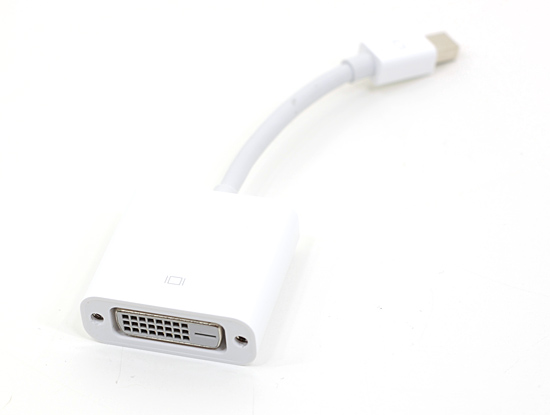
This cable works fine on the Radeon HD 5970, but I couldn't have one of my displays running at a non-native resolution.
Next is the $99 mini DP to dual-link DVI adapter. This box can drive a panel at full 2560 x 1600:
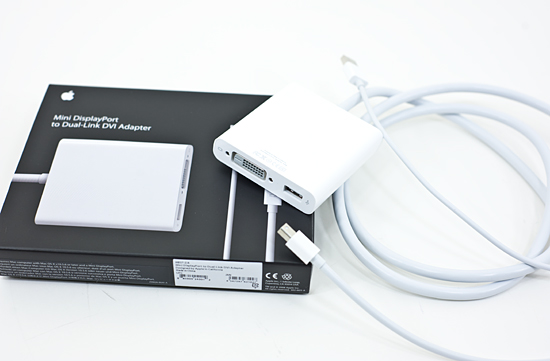
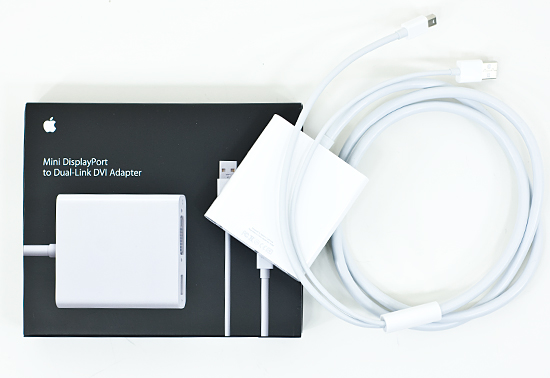
User reviews are pretty bad for this adapter, but thankfully I was using it with a 30" Apple Cinema Display. My experience, unlike those who attempt to use it with non-Apple monitors, was flawless. In fact, I had more issues with one of my Dell panels than this Apple. It turns out that one of my other DVI cables wasn't rated for dual-link operation and I got a bunch of vertical green lines whenever I tried to run the panel at 2560 x 1600. Check your cables if you're setting up such a beast, I accidentally grabbed one of my DVI cables for a 24" monitor and caused the problem.
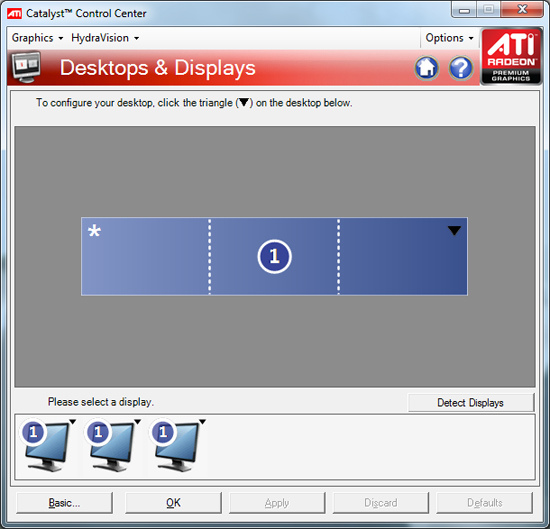
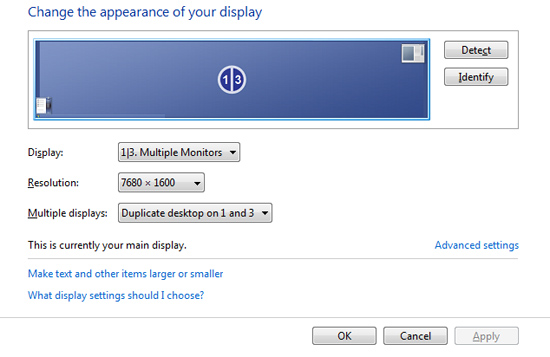
Windows detected all of the monitors, I used the Eyefinity configuration tool to arrange them properly, grabbed a few 7680 x 1600 wallpapers and was at a super wide Windows desktop.
The usual Eyefinity complaints apply here. My start menu was around 3 feet to the left of my head and the whole setup required nearly 6 feet of desk space.
In game menus and cutscenes are also mostly borked. They are fixed resolution/aspect ratio and end up getting stretched across all three 30" panels. Case in point is Call of Duty Modern Warfare 2:
While most games will run at the 7680 x 1600 resolution enumerated by ATI's driver, they don't know how to deal with the 48:10 aspect ratio of the setup (3 x 16:10 displays) and apply the appropriate field of vision adjustments. The majority of games will simply try to stretch the 16:10 content to the wider aspect ratio, resulting in a lot of short and fat characters on screen (or stretched characters in your periphery). Below is what MW2 looks like by default:
All of the characters look like they have legs that start at their knees. Thankfully there's a little tool out there that lets you automatically correct aspect ratio errors in some games. It's called Widescreen Fixer and you can get it here.
Select your game, desired aspect ratio and just leave it running in the background while you play. Hitting semicolon will enable/disable the aspect ratio correction and result in a totally playable, much less vomit inducing gaming experience. Below we have MW2 with correct aspect ratio/FOV:
Take note of how much more you can see as well as normal the characters now look. Unfortunately Widescreen Fixer only supports 11 games as of today, and four of them are Call of Duty titles:
Battlefield 2
Battlefield 2142
BioShock
Call of Duty 2
Call of Duty 4: Modern Warfare
Call of Duty: World at War
Call of Duty: Modern Warfare 2
Darkest of Days Demo
SEGA Rally Revo
Unreal Tournament
Wolfenstein
There's absolutely no reason for ATI not to have done this on its own. There's a donate link on the Widescreen Fixer website, the right thing for ATI to do would be to pay this developer for his work. He's doing the job ATI's Eyefinity engineers should have done from day one. Kudos to him, shame on ATI.
Performance with 3 x 30" displays really varies depending on the game. I ran through a portion of the MW2 single player campaign and saw an average frame rate of 30.9 fps with a minimum of 10 fps and a maximum of 50 fps. It was mostly playable on the Radeon HD 5970 without AA enabled, but not buttery smooth. Turning on 4X AA made Modern Warfare 2 crash in case you were wondering. The fact that a single card is even remotely capable of delivering a good experience at 7680 x 1600 is impressive.
I also noticed a strange issue where I couldn't get my video to sync upon any soft reboots. I'd need to shut down the entire system and turn it back on for me to see anything on the screen after a restart.
With corrected aspect ratios/FOV, gaming is ridiculous on such a wide setup. You really end up using your peripheral vision for what it was intended. The experience, even in an FPS, is much more immersive. Although I do stand by my original take on Eyefinity, the most engulfing gameplay is when you find yourself running through an open field and not in games that deal with more close quarters action.
Just for fun i decided to hook my entire 3 x 30" Eyefinity setup to a power meter and see how much power three 30" displays and a Core i7 system with a single Radeon HD 5970 would consume.
Under load while playing Modern Warfare 2 the entire system only used 517W. Which brings us to the next issue with Eyefinity on the 5970: most games will only use one of the GPUs. Enabling Eyefinity with Crossfire requires a ridiculous amount of data to be sent between the GPUs thanks to the ultra high resolutions supported. Doing this isn't quite that easy given some design tradeoffs made with Cypress (more on this in an upcoming article). Currently, only a limited number of titles will support the 5970 running in dual-GPU mode with Eyefinity. Dual-card owners (e.g. 5870 CF) are out of luck, the current drivers do not allow for CF and Eyefinity to work together. This will eventually get fixed, but it's going to take some time. With a second GPU running you can expect total system power consumption, including displays, to easily break 600W for the setup I used here.
The difficulties most games have with such a wide setup prevent 3 x 30" Eyefinity (or even any triple-monitor configuration) from being a real recommendation. If you have three monitors, sure, why not, but I don't believe it's anywhere near practical. Not until ATI gets a lot of the software compatibility taken care of.


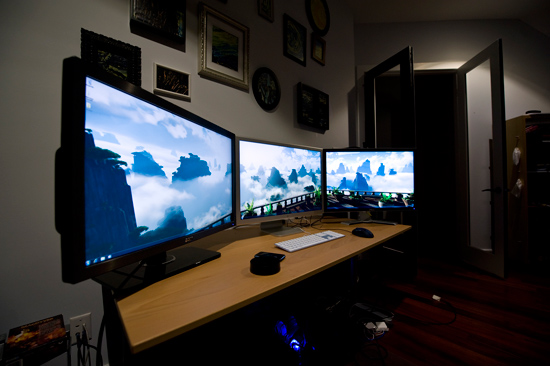

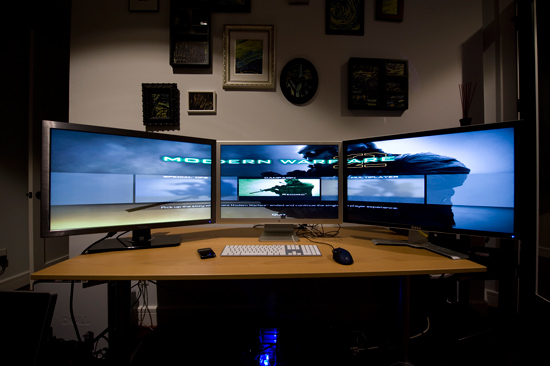
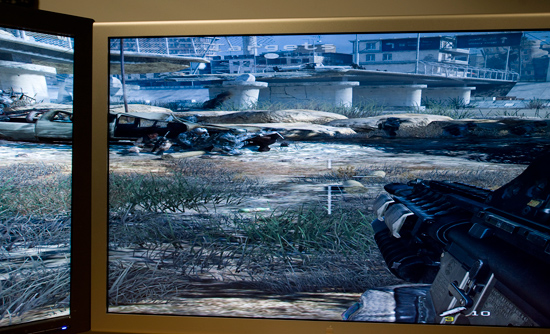
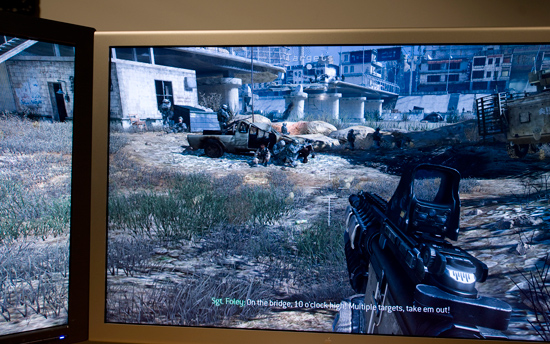








114 Comments
View All Comments
hechacker1 - Wednesday, November 18, 2009 - link
I once had that problem too. Even if my display went to sleep it would reset the monitor configuration.I think disabling this helped:
http://www.tomstricks.com/how-to-disable-or-enable...">http://www.tomstricks.com/how-to-disabl...multimon...
I think eventually catalyst was updated to fix the display loosing connection during sleep (in my case).
The0ne - Wednesday, November 18, 2009 - link
I think we all seen enough data on this poorly programmed game to removed it from the test. There's really not point as even this card, 5970, can choke on it. Seriously, utter crap of programming.lifeblood - Wednesday, November 18, 2009 - link
Three 30" monitors? Dude, I had to work hard just to afford a single 24" monitor. And because I'm salary I don't get overtime (although they do make me work it). If I get a second job flipping burgers at the local fast food joint I might be able to afford two more 24" displays. I bet Eyefinity would still look awesome on that.And I was only kidding about you getting paid too much. The article was great. Now I am eagerly awaiting Nvidia's response.
haplo602 - Wednesday, November 18, 2009 - link
nice review.but PLEASE MARK THE REVIEWED CARD to STAND OUT in the GRAPHS next time. going top down through the list and reading each caption to finaly find the card for EACH GRAPH is realy annoying.
The0ne - Wednesday, November 18, 2009 - link
Anand graphs are really annoying at times. I wish they were more consistent. Xbitlabs are easy and consistent which makes it a breeze for people like me who just wants to look at the specifics.Dante80 - Wednesday, November 18, 2009 - link
I concur, the graphs can be a little confusing without some sort of color coding...Here is a suggestion Ryan. Use light green and orange for Nvidia and AMD single cards, dark green and red for SLI and Xfire setups and lastly, blue for the card reviewed (you can differentiate with light and dark blue readings for the same card in Xfire or OCed readings). I think the graphs would look much better this way, and its a very easy to implement feature anyway...
cheers...^^
SJD - Wednesday, November 18, 2009 - link
Great and interesting article, but I'm confused about this Eyefinity situation again.You state that your monitor didn't support mini-DP, just 'regular' DP, and go on to talk about buying an adapter. Yet, it appears (according to the wiki page at any rate) that mini-DP is electrically identical to regular DP, so only a mini-DP to regular DP cable would be needed. Indeed, other reviews of the 5970 show such an adapter cable included with the card...
What's the score, and why the comment that you need an *active* adapter to go from mini-dp to regular dp?
Simon
strikeback03 - Wednesday, November 18, 2009 - link
The active adapter went to DVI, I was wondering the same about a simple mini-DP to DP cableAnand Lal Shimpi - Wednesday, November 18, 2009 - link
I've clarified :)Once you move to three displays AMD runs out of timing sources, the miniDP port must use an active adapter if you're using three displays.
Take care,
Anand
mczak - Wednesday, November 18, 2009 - link
This is however incorrect. You need active adapters because rv870 only supports 2 clock sources for display outputs. However, DP (or mini-DP) don't need any such clock source because they use a fixed clock independent from display timings. Hence, if you want to connect more than 2 monitors using DVI/HDMI/VGA you need active DP-to-something adapter. But for DP outputs this isn't needed. And mini-DP is the same as DP anyway electrically.